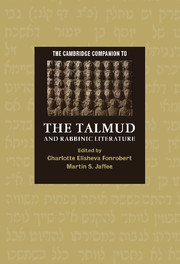Book contents
- Frontmatter
- Introduction: The Talmud, Rabbinic Literature, and Jewish Culture
- Part I: The Conditions of Rabbinic Literary Activity
- Part II: The Genres of Rabbinic Literary Composition
- Part III: Hermeneutical Frames for Interpreting Rabbinic Literature
- 11 The “Other” in Rabbinic Literature
- 12 Regulating the Human Body: Rabbinic Legal Discourse and the Making of Jewish Gender
- 13 Rabbinic Historiography and Representations of the Past
- 14 Rabbinical Ethical Formation and the Formation of Rabbinic Ethical Compilations
- 15 Hellenism in Jewish Babylonia
- Bibliography
- Index
- Source Index
- Series List
11 - The “Other” in Rabbinic Literature
from Part III: - Hermeneutical Frames for Interpreting Rabbinic Literature
Published online by Cambridge University Press: 28 November 2007
- Frontmatter
- Introduction: The Talmud, Rabbinic Literature, and Jewish Culture
- Part I: The Conditions of Rabbinic Literary Activity
- Part II: The Genres of Rabbinic Literary Composition
- Part III: Hermeneutical Frames for Interpreting Rabbinic Literature
- 11 The “Other” in Rabbinic Literature
- 12 Regulating the Human Body: Rabbinic Legal Discourse and the Making of Jewish Gender
- 13 Rabbinic Historiography and Representations of the Past
- 14 Rabbinical Ethical Formation and the Formation of Rabbinic Ethical Compilations
- 15 Hellenism in Jewish Babylonia
- Bibliography
- Index
- Source Index
- Series List
Summary
Group identity is a social and cultural construct that may be defined as a group's subjective sense of itself as being different from other groups. Since ancient times, the identity of Israel has been explored and constructed in opposition to gentile, or alien, others. But the self-other dyad is by no means stable or constant. Dramatic changes in the political and cultural conditions of Jewish life in Antiquity led inevitably to revision and renegotiation of the self-other dichotomy. Moreover, the self-other dichotomy can be differently constructed by different elements within a single ethnic or religious group, leading to internal conflict over the self-definition and boundaries of that group. These tensions may contribute to the formation of distinct sects espousing different views on the group's identity and the nature of the boundaries that serve to demarcate and preserve that identity. Identity construction is thus a complex task, as a group defines itself not only in contrast to other groups (“external others”) but also in contrast to members of its group that would contest the group's identity or construct it in a different way (“internal others”).
In rabbinic literature, reference is made to non-Israelites (gentiles of various descriptions). These “external others” often appear in rabbinic literature as mirror opposites of Israelites, and so sharpen the rabbis' definition of Israel. However, insofar as this literature explores and develops a definition of the rabbi as the ideal Jew, reference is made to non-rabbinic Jews (of various descriptions). These “internal others” often appear in rabbinic literature as mirror opposites of the rabbisand so sharpen the rabbis' definition of their own class.
- Type
- Chapter
- Information
- The Cambridge Companion to the Talmud and Rabbinic Literature , pp. 243 - 269Publisher: Cambridge University PressPrint publication year: 2007
- 3
- Cited by



